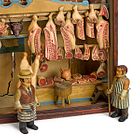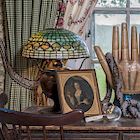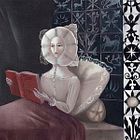Antique Coin-Op Machines And Early Advertising Signs at Morphy's
DENVER, Pa. – Long before the era of instant entertainment from TV, downloaded music and streaming videos, Americans could amuse themselves with a pocketful of change at an arcade. The thrilling atmosphere of those places, whether indoors or on a seaside boardwalk, resonated with the clanging and whirring of slot machines, the pinging of bagatelles, and orchestral tunes performed by mechanical music machines. Coin-ops were also found in saloons and other social establishments. Today, the mechanical entertainers of yesteryear are displayed in collections from coast to coast, often flanked by antique advertising signs of the same period. Many of the rarest and finest of all antique coin-ops and signs have passed through the doors of Morphy Auctions, which will hold its next sale of these popular specialties on May 4-6.
Advertising tray with image of pretty lady in patriotic attire, emblazoned ‘Drink Deacon Brown King of Phosphates,’ Manufactured by Kauffmann and Strauss, New York, and dated 1911. Condition 9.5+ and arguably the finest known example. Estimate $8,000-$12,000
The connoisseur’s selection features more than 2,100 coveted 19th- and early 20th-century coin-ops and advertising signs that would seldom be available elsewhere, especially in such beautiful condition.
Morphy’s will strike up the band with a JP Seeburg Style “G” Art Style Orchestrion, a technological marvel that is as stunningly beautiful as it is intricate. Designed as an upright piano with four art glass panels illuminated from within, it also houses violin and flute pipes; a mandolin attachment, a tympani, bass and snare drums; a cymbal and triangle. With exceptional volume, it plays a Style “G” music roll with a selection of 65 notes. In very good condition, the Orchestrion could crescendo in the $40,000-$60,000 range.
A rare and very early (pre-1902) version of Schiemer-Yates’ 5-cent Musical Cupid upright slot machine is notable for having been manufactured prior to the formation of both Caille-Scheimer and its successor, Caille Brothers. Its cabinet is somewhat smaller than others of its day, yet it boasts full-size castings, rendering an alternative appearance that makes it especially appealing to collectors. Its original music mechanism rests atop an attached echo chamber that renders outstanding sound and tone. This turn-of-the-century beauty is in excellent condition, ready to play and pay. It retains its keys and comes to auction with a $30,000-$50,000 estimate.
One of Regina’s earliest musical accomplishments is the extremely rare Style 3 Seth Thomas hall-clock model, whose peak of popularity was between 1895 and 1905. Towering over 9 feet tall, it contained a 15½in duplex comb movement and would automatically play music upon striking on the hour, or by the pressing of a side button. The oak-cased example offered by Morphy’s – whose origins are unknown prior to its 1989 purchase from an estate – is unique in that it is the only known Regina Style 3 with a coin slot. The Encyclopedia of Automatic Musical Instruments by David Bowers refers to the existence of only one example of this model with a coin slot and states that it had stood in a hotel lobby for years. Estimate: $10,000-$20,000
A very rare circa-1902 Watling musical “Puck” 5-cent upright slot machine comes with provenance that is only degree away from one of the greatest of all heavyweight boxers. It was originally owned by Jack Dempsey’s friend and sparring partner, Eddie Bohns. For 65 years, Bohns presided over North Denver’s legendary Pig ‘N Whistle, a restaurant and sports bar that attracted scores of professional athletes and other celebrities, including Roy Rogers, the Dorsey brothers, and astronaut Wally Schirra. The Puck machine to be auctioned features a quartered-oak cabinet with all original castings, a lithographed Puck wheel, and the original music feature. In impeccable condition, with keys, it is estimated at $30,000-$50,000.
There’s likely to be strong competition over a Mills “The Pilot” 5-cent cast-iron counter drum trade stimulator with nautical scenes on its front and sides. These original castings are unique to The Pilot and were never utilized on any other Mills machine. The unit was designed to reward winners with trade checks valued from 10 cents to $2. In excellent working order with an included key, this highly desirable antique is estimated at $15,000-$25,000.
Collectors of early vending machines will have 120 stellar options from which to choose. Leading the category is an incredible 1899 Huyler’s 1-cent vending machine designed to dispense both Huyler’s Chocolate and St Nicholas Pepsin Gum. Its rich cobalt blue and white porcelain panels, which are mounted to a wood case, feature images of St Nicholas holding advertising placards for the gum brand. Its mechanism is of cast bronze and iron. A similar example appears in the reference book Silent Salesman Too, by Bill and Peggy Enes. In impeccable condition, this machine is ready to dispense pride of ownership to the winning bidder, but it will cost more than a penny. Its pre-sale estimate is $40,000-$60,000.
A pepsin gum-vending machine with historical context is the Diavalo Loop the Loop, which is based on a daredevil bicyclist who made the rounds of turn-of-the-century circuses. When a penny is dropped into the slot, Diavalo performs a loop on the bicycle track encircling the front window and the patron receives a tab of gum. Similar to an example shown in the aforementioned Silent Salesman Too, the machine comes with prestigious provenance from Sotheby’s 1994 auction of the Dr James W Smith Jr collection. Estimate: $20,000-$40,000
More than 400 lots of Coca-Cola advertising await bidders, including an extremely rare late-19th-century round glass sign touting the soft drink as “The Ideal Brain Tonic” and a remedy for headaches and both “Mental & Phisical Exhaustion.” Graded 7.8 and the only known survivor of its type, it is estimated at $10,000-$20,000. Also, displaying unbelievable 9.25 condition with no visible fading whatsoever, a circa-1914 self-framed, lithographed tin Coca-Cola sign serves to showcase the pretty-in-pink model known as “Betty Girl.” The 41- by 31-inch sign invites bids in the $6,000-$10,000 range.
The parade of soft-drink rarities continues with an embossed and painted tin Moxie sign bearing the messages: “It’s So Healthful, So Strengthening,” and “Of Course You’ll Have Some.” To demonstrate the beverage’s effervescent quality, its central image depicts a lavishly gowned lady who smiles as she elegantly pours the product from bottle to glass. The sign is in excellent condition with vivid colors and nice gloss, and is presented in a period-correct wood frame. Estimate: $12,000-$16,000
Another soft-drink highlight is the bright and colorful advertising tray emblazoned “Drink Deacon Brown King of Phosphates.” Dated 1911, three years before the outbreak of World War I, its patriotic theme includes the Stars and Stripes, and the image of a lovely young lady lifting a glass of the beverage to her lips. Manufactured by Kauffmann and Strauss, New York, the tray is in 9.5+ condition. Arguably the finest known example, its auction estimate is $8,000-$12,000.
A very early lithographed-tin sign advertises “Sleepy Eye The Meritorious Flour” and features an oval central image of Sisseton Dakota Indian Chief “Old Sleepy Eye” surrounded by several well detailed images of Native Americans, buffalo, a bear, and “beaded” or “feathered” Native attire. Both the graphics and colors are extraordinary, earning the sign a condition rating of 9. Estimate: $8,000-$12,000.
Morphy’s Wednesday/Thursday/Friday, May 4, 5 and 6, 2022 Coin-Op & Antique Advertising Auction will be held live online via Bidsquare.
By Morphy Auctions
Copyright © 1999 - 2025 Morphy Auctions. All Rights Reserved.
- Post-Auction Press Release, Americana Auction, October 1,2,3, 2025 at Pook & Pook
- TURNER AUCTIONS + APPRAISALS PRESENTS THE GLADYNE K. MITCHELL COLLECTION ESTATE ON JULY 19
- Celebrate American Heritage with Dana Auctions’ January 25 Antique and Vintage Quilt and Textile Auction
- Exciting Online Auction from Rafael Osona Auctions - Exceptional offerings across multiple categories
- DIAMONDS ARE FOREVER: FINE JEWELRY, DIAMONDS & MORE COME TO TURNER AUCTIONS + APPRAISALS
- TAKE TIME OUT TO VIEW SPORTS MEMORABILIA, COMING TO TURNER AUCTIONS + APPRAISALS ON AUGUST 17
- Rafael Osona Announces Two Day Auction, Aug 3 & 4, 2024 Americana, Fine Arts, Historic Nantucket, Décor ~ Saturday, August 3 The Marine Session ~ Sunday, August 4 Open for Bidding ~ 1000 Lots ~
- Kobe Photomatched Final Game Worn Warm-Up Takes the Stage in SCP’s Summer Premier Auction
- BOHEMIAN CLUB & BOHEMIAN GROVE POSTERS, BOOKS & EPHEMERA COME TO TURNER AUCTIONS + APPRAISALS ON AUGUST 10
- Rafael Osona's Early Summer Auction Gallery Preview July 3,4,5 Auction July 6 - 700 lots
-
Antique Toy Auction at Pook & Pook Inc, with Noel Barrett

-
Sporting Immortality

-
The Collection of Mrs. John Gutfreund – Murray House, Villanova, Pennsylvania

-
Leonora Carrington Oil Painting Sells for More Than Twice the Asking Price in the Latin American Art Auction Hosted by Morton Subastas in Mexico City

-
Peter Tillou Collection Highlights Litchfield Auctions’ 25th Anniversary




 EUR
EUR CAD
CAD AUD
AUD GBP
GBP MXN
MXN HKD
HKD CNY
CNY MYR
MYR SEK
SEK SGD
SGD CHF
CHF THB
THB

